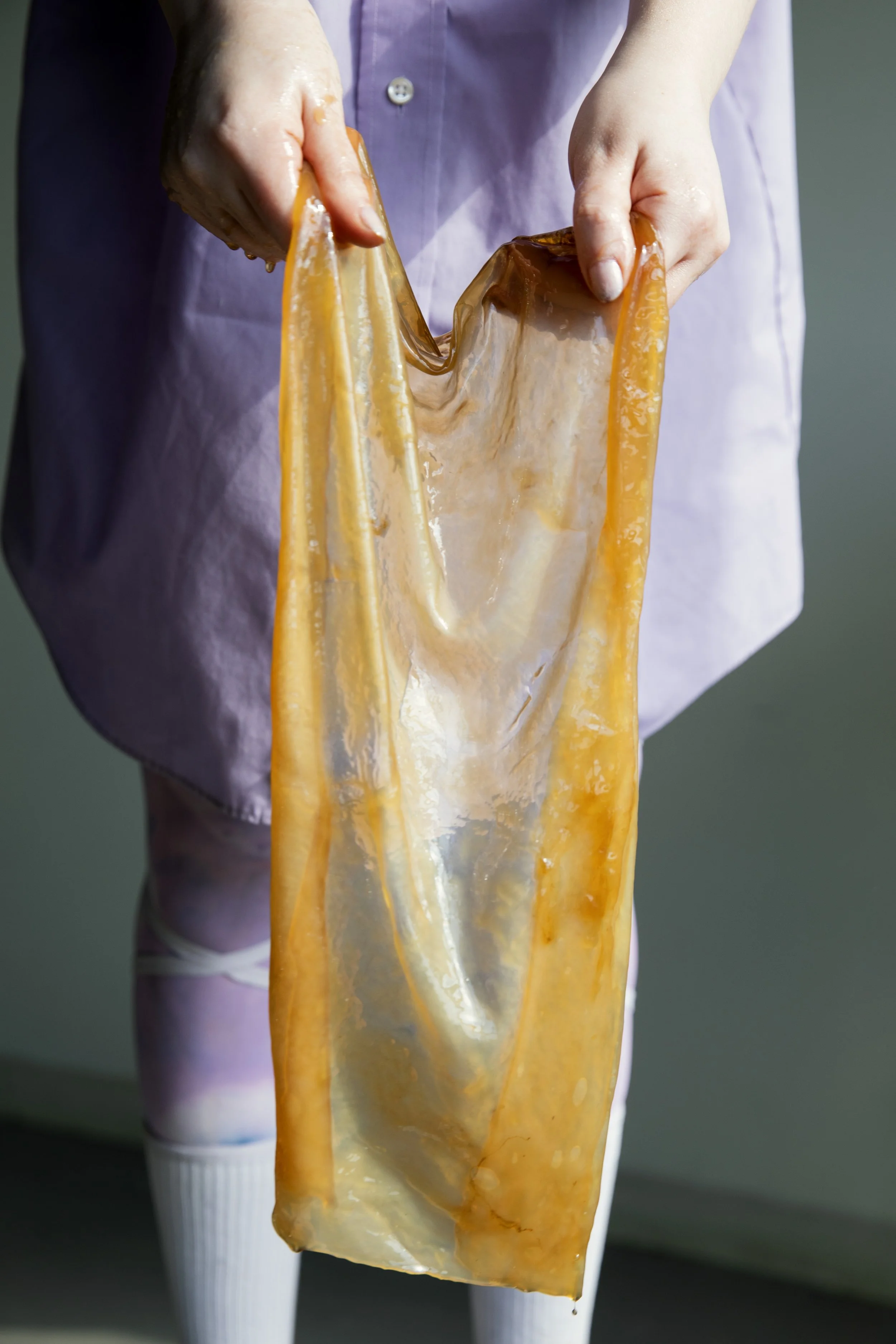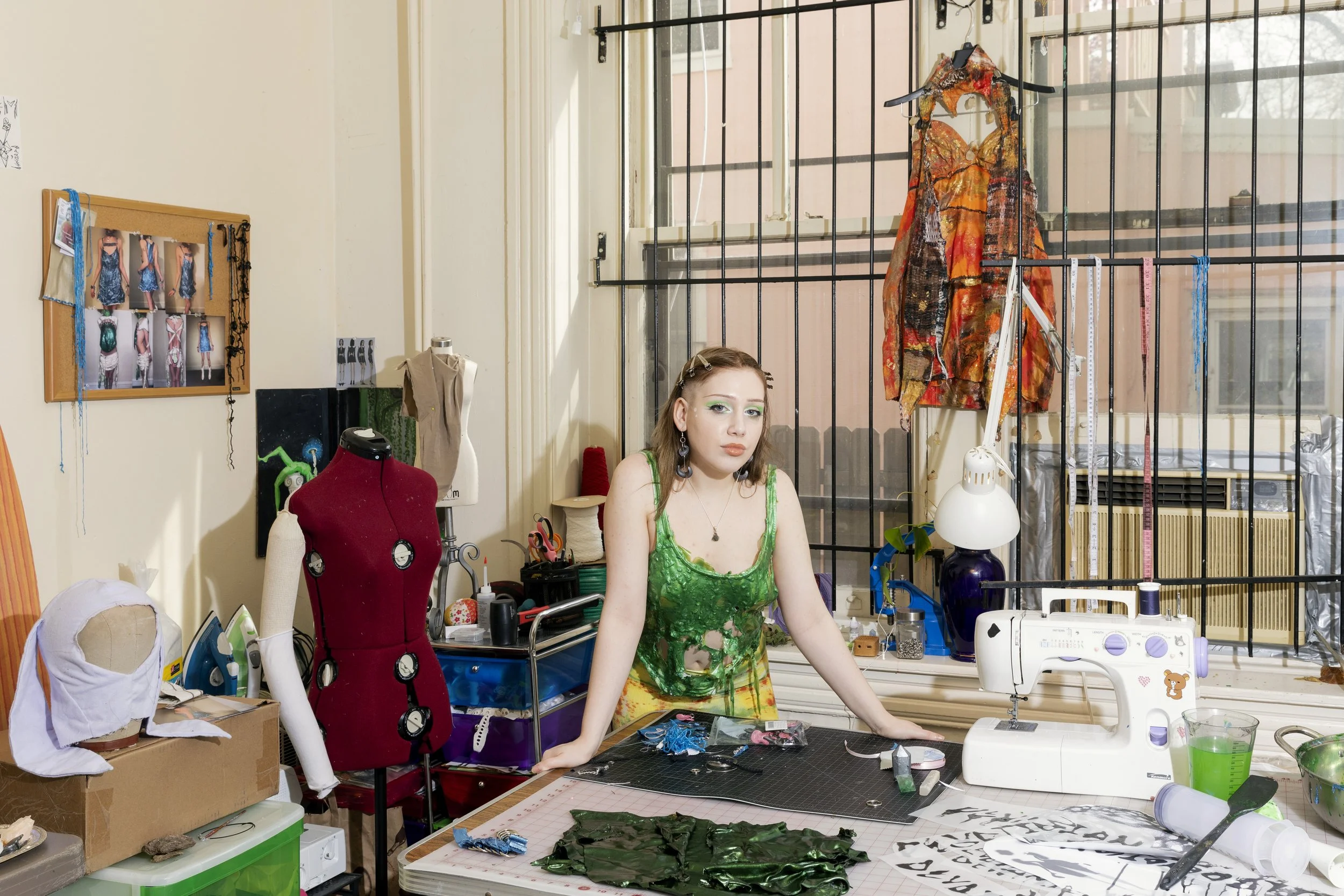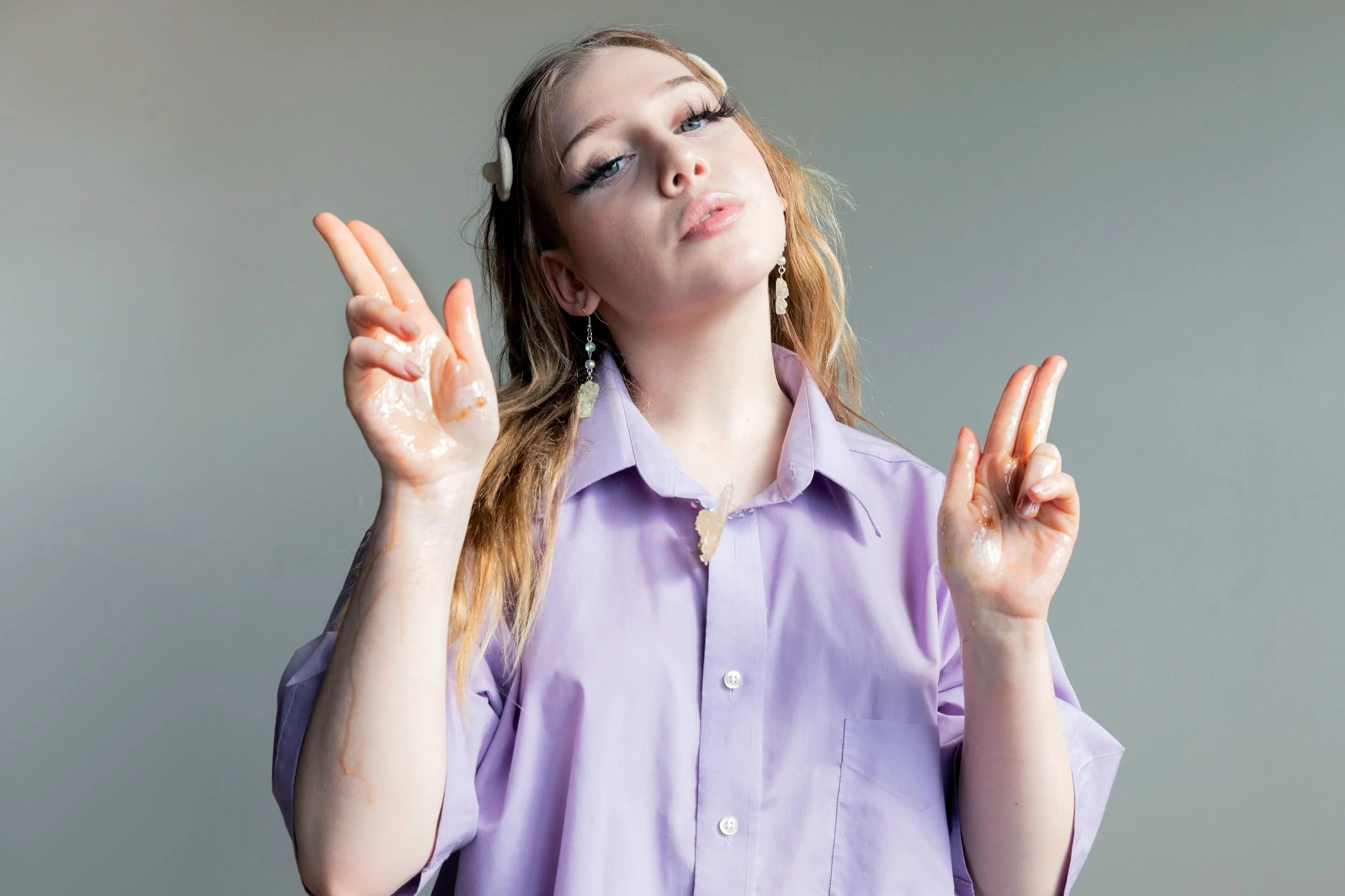Shirp: Princess, Scientist, and Eco-Pioneer
Written by: Taylor Kim | Photography by: Rachel Schmidt
In her home lab, Shirp concocts textiles with bioplastic, mycelium, and algae. We get a sneak peek of Shirp’s eccentric designs inspired by microscopic worlds and couture fetishwear.
I am excited for the future of sustainable design after speaking with my longtime friend and Drexel fashion design senior, Shirp, who describes herself as “a multi-dimensional textile engineer coming from a background of environmental and human-conscious design.” Shirp’s elaborate eco-fashion designs and incredible cosmetic artistry are displayed on her Instagram. Her handle is aptly named @princess.shirp, since her craftsmanship and otherworldly presence truly elevates her to royalty and makes everyone else look like commoners in comparison.
Shirp was born a creative powerhouse. She starred in plays, created small books, and was always eager to pick up new artistic outlets. She learned how to sew at the age of 12 when she wanted to make her dress for her Bat Mitzvah. Her motivation kick-started her love of garment design, and she quickly decided she wanted to become a fashion designer. However, people around her would try to discourage her by saying, “You’re not going to make money” and “You can’t get anywhere in the arts.” Shirp recalls with a laugh, “So I had it in my mind, maybe for like three years, that I was going to be a dentist.” Thankfully, she realized she wanted to be a designer and did not let other people interfere with her aspirations. During her early years as a designer, instead of flipping through the pages of Vogue, she would look to Tumblr, YouTube, and even horror films for fashion inspiration. Shirp’s most impactful influences in her teenage years were her friends, who would have fun dressing in eccentric outfits, with their only goal being to create an outfit better than their last.
Fast-forward to the present day, Shirp is rounding out her final year as a Fashion Design student at Drexel University’s Westphal College of Media Arts & Design. An eco-conscious vegan since the age of 15, her coursework helped increase her interest in plant-based textiles and sustainable design. In a knitwear class, she learned how mycelium, the vein-like nervous system of a mushroom, can be turned into a textile. Shirp further explains that mycelium can spread miles and miles under forests communicating with all things growing there. Your berries that go bad in the fridge and turn white – what you’re seeing is mycelium. The concept of mycelium being used as an alternative material began when people discovered leather-like fungus growing on logs in a forest.
In temperature-controlled environments and given specific food, mycelium can be grown into dense sheets by scientists. Mycelium is very efficient; it grows very fast, doesn’t need much water, requires no light to grow, and is completely biodegradable and waterproof.
Shirp has grown mycelium using oyster mushroom spores and feeding them with hemp chips in her basement for two weeks. The mycelium was eventually used for a trial pair of high heel soles that turned out to hold weight well. Furthermore, fungi can be formed into packaging boxes, packing foam, and it even can be 3D printed to grow into furniture and structures such as homes.
In a sustainable accessories class with Professor Elizabeth Quinn, Shirp got the chance to grow mushroom mycelium for the first time and learned that adding different ingredients to mycelium to create a liquid mixture would dry to create a fabric. “I probably found [online] over 200 recipes on all the different ways to make different types [of mycelium textiles],” she tells me. In some of these recipes, alginate, a derivative of algae, is added to the textile to improve resiliency, strength, and flexibility.
Shirp has been experimenting with kombucha leather, one of her favorite innovations using food and drink to make plant-based leather. Kombucha is fermented tea, and when it goes through the fermentation process, a bacteria and yeast byproduct is created called SCOBY, which stands for symbiotic culture of bacteria and yeast. The bacteria organisms of the SCOBY eat the caffeine and sucrose in the caffeine tea to grow into round sheets. It takes about 3 weeks for a ¼-⅜ inch thick layer to grow. Then the SCOBY sheets are removed from the fermented liquid and separated from each other to be hung up and dried, ready to be tanned like real leather. By communicating with other kombucha designers and conducting her own research, Shirp has found that natural linseed mixing mediums used for oil paint work best as a kombucha leather tanning solution. The oil is massaged onto the dried SCOBY, which helps turn the brittle dry material into a flexible textile. Untanned kombucha SCOBY can even be processed and pressed to form a wood-like material that is strong and reliable. For her future garments, Shirp plans to use tanned kombucha SCOBY that is dyed with spirulina algae to give it a deep sapphire blue color.
Textiles made from mycelium and kombucha are both considered bioplastics – plastics created from natural and renewable sources in contrast to traditional petroleum-based plastics. I ask Shirp about the longevity of a typical garment made from bioplastic; she says these kinds of garments will last about six months and need to be wiped clean instead of thrown into a washer. Bioplastics are a great alternative for fast fashion textiles. The biodegradable quality of bioplastic can significantly reduce the amount of textile waste generally created when clothing, especially non-biodegradable polyester clothing, is discarded in landfills month after month.
In June 2022, Shirp will be presenting her senior collection at the annual Drexel Fashion Show. The central theme is the idea of worlds existing within worlds and the relationship between what we physically see with our eyes and what we can only see through a microscope. There will be an emphasis on biomaterial and the idea of perfect structural shapes existing amidst the imperfection of nature. Couture designers such as Nusi Quero, Iris Van Herpen, and Stella McCartney, influence Shirp’s work. Fetish wear and the BDSM subculture, also inspires her because of the impact it has on people when they see it. “I love freaking people out with extreme fashion. I find it satisfying to make someone think differently or impose new ideas so directly,” she says. The directness and provocativeness of fetish fashion inspires Shirp to be direct in her environmental designs instead of beating around the bush.
Through her work, she wants people to understand the raw severity of the textile crisis; the way that fashion is destroying lives, communities, ecosystems, animals, and the Earth.
Further explaining her thesis, Shirp says, “Fetishwear connects people, like mycelium connects a forest. The fetish world creates a system of boundaries and rules, safety and guidelines. I see the world of bondage as a healing practice to individuals, as biodegradable materials are to the world. I couldn’t help but think it was a genius idea to merge the two, as it is so rare that new things are brought into fashion and high couture. So, I am incredibly excited to provoke people with sexy pieces using biodegradable concepts and materials.” With the show taking place in June, Shirp has already started to create crochet samples using yarn made from algae bioplastic, which she describes as feeling very rubber-like.
Shirp’s next steps after graduation will be to seek more education on the science of textile engineering and topics like biomimicry- an approach to innovation that learns from and mimics the strategies found in nature to solve human design challenges. She wants to delve more into mycelium research and explore how textile innovations transform fashion, architecture, and furniture. “I’m really interested in having buildings made from mycelium,” she tells me.
Shirp dreams of the day celebrities will be wearing her biodegradable couture designs, which she feels is the most straightforward way to get consumers’ attention about the infinite possibilities of biodegradable textiles and hopefully push it to become more mainstream. “I think if people who are very famous start wearing biodegradable materials, it will get the conversation going and spark change,” she says. Sooner or later, textile industries from areas of fashion, industrial, aerial, and automotive are going to be using all things bio-based.




